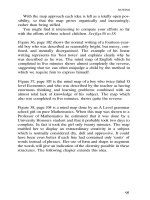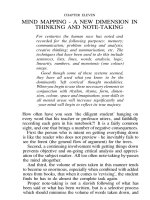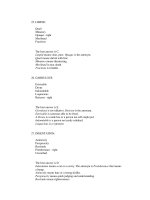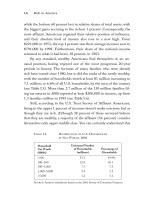tony buzan mind maps and making notes phần 2 ppt
Bạn đang xem bản rút gọn của tài liệu. Xem và tải ngay bản đầy đủ của tài liệu tại đây (75.29 KB, 10 trang )
NOTING
Last evening - the twenty-ninth of the eleventh month - an
odd feeling came to me as I sat at my desk: a sense of emptiness
in the room. Then I became aware that my grass-lark was silent,
contrary to his wont. I went to the silent cage, and found him
lying dead beside a dried-up lump of egg-plant as gray and hard
as a stone. Evidently he had not been fed for three or four days;
but only the night before his death he had been singing
wonderfully - so that I foolishly imagined him to be more than
usually contented. My student, Aki, who loves insects, used to
feed him; but Aki had gone into the country for a week's holiday,
and the duty of caring for the grass-lark had developed upon
Hana, the housemaid. She is not sympathetic, Hana the
housemaid. She says that she did not forget the mite - but there
was no more egg-plant. And she had never thought of
substituting a slice of onion or of cucumber! I spoke words
of reproof to Hana the housemaid, and she dutifully expressed
contrition. But the fairy-music had stopped: and the stillness
reproaches; and the room is cold, in spite of the stove.
Absurd! I have made a good girl unhappy because of an
insect half the size of a barley-grain! The quenching of that
infinitesimal life troubled me more than I could have believed
possible Of course, the mere habit of thinking about a
creature's wants - even the wants of a cricket - may create, by
insensible degrees, an imaginative interest, an attachment of
which one becomes conscious only when the relation is broken.
Besides, I had felt so much, in the hush of the night, the charm
of the delicate voice - telling of one minute existence dependent
upon my will and selfish pleasure, as upon the favour of a god -
telling me also that the atom of ghost in the tiny cage, and the
atom of ghost within myself, were forever but one and the same
in the deeps of the Vast of being And then to think of the
little creature hungering and thirsting, night after night and day
after day, while the thoughts of his guardian deity were turned to
the weaving of dreams! How bravely, nevertheless, he sang
on to the very end - an atrocious end, for he had eaten his own
legs! May the gods forgive us all - especially Hana the
housemaid!
75
Yet, after all, to devour one's own legs for hunger is not the
worst that can happen to a being cursed with the gift of song.
There are human crickets who must eat their own hearts in
order to sing.
Key words or phrases for main and secondary ideas from
Kusa-Hibari
main secondary
paragraph 1
paragraph 2
paragraph 3
paragraph 4
Below you will find sample key words and phrases from the notes
of students who have previously done this exercise. Briefly com-
pare and contrast these with your own ideas.
Students' suggested key words and phrases
main secondary
paragraph 1 his cage two Japanese inches
wooden door wooden floor
ceiling of gauze plenty of room
small insect discover whereabouts
76
paragraph 5
In class situations instructors then circled one word from each
section:
paragraph 1
1
3
4
5
wooden door
weight in gold
occupied
penetrating
love
secondary
discover whereabouts
market
pains
hour of dawn
night-life
Students were then asked to explain why, in the context of the
exercise, these words and phrases and not others had been
selected. Answers usually included the following: 'good image
words', 'imaginative', 'descriptive', 'appropriate', 'good for re-
membering', and 'evocative', etc.
77
NOTING
paragraph 2 cricket Grass-Lark
weight in gold twelve cents
antennae market
Kusa-Hibari gnatlike
paragraph 3 sleep fresh cucumber
clean and well fed pains
occupied meditation
absurd small
paragraph 4 penetrating silvery rippling
music house vibrating
electric bells penetrating
soul hour of dawn
paragraph 5 Love night life
amorous insect merchant
the hills significance
Death love and death
Only one student in fifty realised why the instructors had
chosen these words: in the context of the exercise the series
chosen was disastrous.
To understand why, it is necessary to imagine a time some
years after the story has been read when you are going to look at
the notes again for recall purposes. Imagine that some friends
have played a prank, taking out the title cards of some of your
stories and challenging you to remember the titles and authors.
You would have no idea to start with to which story your cards
referred, and would have to rely solely on them to give you back
the correct images.
With the key words at the bottom of page 77, you would
probably be forced to link them in the following way: 'wooden
door', a general phrase, would gain a mystery-story air when you
read 'discover whereabouts'. The next two keys 'weight in gold'
and 'market' would confirm this, adding a further touch of
intrigue suggesting a criminal activity. The next three key words,
'occupied' 'pains' and 'penetrating' might lead you to assume
that one of the characters, perhaps the hero, was personally in
difficulty, adding further tension to the ongoing plot as the 'hour
of dawn', obviously an important and suspense-filled moment in
the story, approached. The final two keys, 'love' and 'night-life'
would add a romantic or risque touch to the whole affair,
encouraging you to thumb quickly through the remaining key
words in search of further adventures and climaxes! You would
have created an interesting new story, but would not remember
the original one.
Words which seemed quite good at the time have not, for some
reason, proved adequate for recall. To explain why, it is
necessary to discuss the difference between key recall words and
key creative words, and the way in which they interact after a
period of time has passed.
A key recall word or phrase is one which funnels into itself a
wide range of special images, and which, when it is triggered,
funnels back the same images. It will tend to be a strong noun or
verb, on occasion being surrounded by additional key adjectives
or adverbs. See fig 26.
78
NOTING
same order of
information funnelled
out when key word is
triggered
Fig 26 Diagram representing key recall word. See text on opposite page.
A creative word is one which is particularly evocative and
image-forming, but which is far more general than the more
directed key recall word. Words like 'ooze' and 'bizarre' are
especially evocative but do not necessarily bring back a specific
image. See fig 27.
Fig27 A creative word sprays out associations in all directions. See
text this page.
Apart from understanding the difference between creative and
recall words, it is also necessary to understand the nature of
words themselves as well as the nature of the brain which uses
them.
79
information
funnelled in
key word
Every word is 'multi-ordinate', which simply means that each
word is like a little centre on which there are many, many little
hooks. Each hook can attach to other words to give both words in
the new pair slightly different meanings. For example the word
'run' can be hooked quite differently in 'run like hell' and 'her
stocking has a run in it'.
Fig 28 Each word is multi-ordinate, meaning that it has a large
number of'hooks'. Each hook, when it attaches to another word,
changes the meaning of the word. Think, for example, of how the
word 'run' changes in different phrase contexts. See text pages 79 and
80
In addition to the multi-ordinate nature of words, each brain
is also different from each other brain. As shown in the first
chapter, the number of connections a brain can make within
itself is almost limitless. Each individual also experiences a very
different life from each other individual (even if two people are
enjoying the 'same experience' together they are in very different
worlds: A is enjoying the experience with B as a major part of it,
and B is enjoying the experience with A as a major part of it).
Similarly the associations that each person will have for any word
will be different from everybody else's. Even a simple word like
'leaf will produce a different series of images for each person
who reads or hears it. A person whose favourite colour is green
might imagine the general greenness of leaves; someone whose
favourite colour is brown, the beauty of autumn; a person who
had been injured falling out of a tree, the feeling of fear; a
80
NOTING
gardener, the different emotions connected with the pleasure of
seeing leaves grow and the thought of having to rake them all up
when they had fallen, etc. One could go on for ever and still not
satisfy the range of associations that you who are reading this
book might have when you think of leaves.
As well as the unique way in which the mind sees its personal
images, each brain is also, by nature, both creative and sense-
organising. It will tend to 'tell itself interesting and entertaining
stories' as it does for example when we day- or night-dream.
The reason for the failure of the recall and creative words
selected from Kusa-Hibari can now clearly be seen. When each
of the multi-ordinate words or phrases was approached, the
mind automatically picked the connecting hooks which were
most obvious, most image-producing, or the most sense-making.
The mind was consequently led down a path that was more
creative than recall based, and a story was constructed that was
interesting, but hardly useful for remembering.
Fig29 Showing how mind can follow the Strong connections' in a
series of key words. See text this page.
Key recall words would have forced the mind to make the proper
links in the right direction, enabling it to recreate the story even
if for all other intentional purposes it had been forgotten.
Fig30 Direction of correct associations when proper recall key
words have been used. See text this page.
81
Key versus standard notes
The main body of a person's recalling is of this key concept
nature. It is not, as is often assumed, a word-for-word verbatim
process. When people describe books they have read or places
they have been to, they do not start to 're-read' from memory.
They give key concept overviews outlining the main characters,
settings, events and add descriptive detail. Similarly the single
key word or phrase will bring back whole ranges of experience
and sensation. Think for example of the range of images that
enter your mind when you read the word 'child'.
How, then, does acceptance of these facts about key recall
affect our attitude toward the structure of note taking?
Because we have become so used to speaking and writing
words, we have mistakenly assumed that normal sentence struc-
ture is the best way to remember verbal images and ideas. Thus
the majority of students and even graduates have taken notes in a
normal literary fashion similar to the example of a university
student whose notes were rated 'good' by his professor. See facing
page.
Our new knowledge of key concepts and recall has shown that
in this type of notes 90 per cent of the words are not necessary
for recall purposes. This frighteningly high figure becomes even
more frightening when a closer look is taken at what happens
with standard sentence notes:
1 Time is wasted recording words which have no bearing on
memory (estimated waste - 90%).
2 Time is wasted re-reading the same unnecessary words
(estimated waste - 90%).
3 Time is wasted searching for the words which are key, for they
are usually not distinguished by any marks and thus blend in
with other non-recall words.
4 The connections between key words are interrupted by words
that separate them. We know that memory works by associa-
tion and any interference by non recall words will make the
connections less strong.
5 The key words are separated in time by intervening words:
after one key word or phrase has been read it will take at least
82
NOTING
Fig 31 An example of traditionally 'good' university student's notes.
See text on opposite page.
83
a few seconds to get to the next. The longer the time between
connections, the less chance there will be of proper connec-
tion being made.
6 The key words are separated in space by their distance from
each other on the page. As with the point made about time,
the greater the distance between the words, the less chance of
there being a proper connection.
You are advised to practise key word and phrase selection from
any previous notes made during periods of study. It will also be
helpful at this point for you to summarise this chapter in key note
form.
In addition, reconsider key and creative words in the light of
the information in the chapter on Memory, especially the section
dealing with mnemonic techniques. Similarly the memory chap-
ter itself can be reconsidered in the light of this chapter, with a
similar emphasis on the relationship and similarities between
mnemonic systems and key and creative concepts.
The review graph is another important consideration. Review
is made much easier when notes are in key form, because less
time is expended, and because the recall itself will be superior
and more complete. Any weak linkages will also be cemented
more firmly in the early stages.
Finally, linkages between key words and concepts should
always be emphasised and where possible simple lists and lines
of key words should be avoided. In the following chapter
advanced methods of key word linking and patterning will be
explained in full.
84









